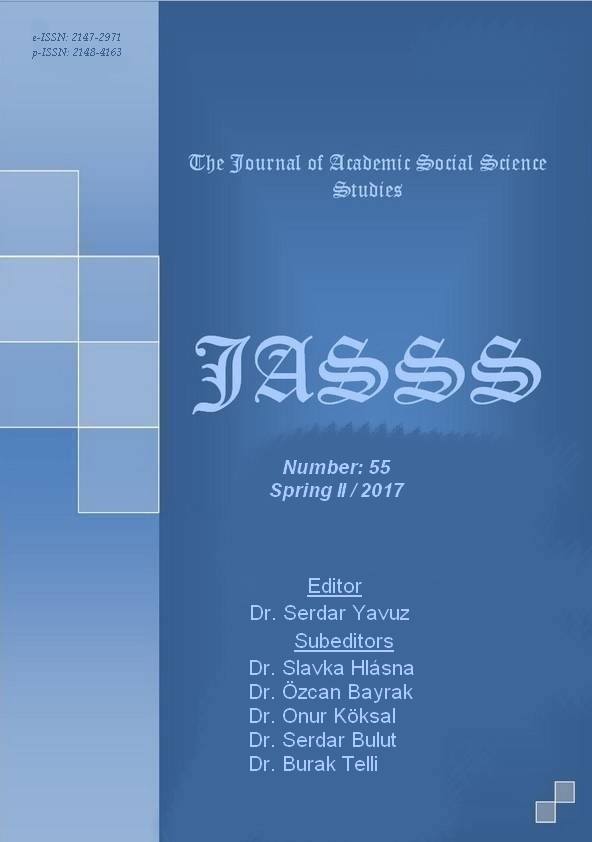Author :
Abstract
XX. yüzyılda, sanatta nesnel dünyanın terk edilişiyle birlikte, sanatın da yüzünde de değişimler meydana gelmiştir. Bu yüzyılda insan duyularının ötesinde, akılla kavranan resmin, kendi plastik öğelerini ortaya koyduğu dönemde, sanatçıların bakış açılarında köklü bir değişiklik olmuştur. Sanatta, doğanın taklidinden uzaklaşmış, geometrik öğelerin hacimlendirilmeye başvurulmadan, ana renklerle kullanıldığı, dengeli kompozisyonlar ortaya çıkmaya başlamıştır. Bu akım Neo-Plastisizm (Yeni-Plastikçilik) olarak karşımıza çıkmaktadır. Piet Mondrian, Theo Van Doesburg, Bart van der Leck, Georges Vantongerloo, Vilmos Huszár gibi sanatçıların oluşturduğu bu Neo-Plastisizm akımı, XX. Yüzyılda etkili olmuştur. Bu çalışmada, Neo-plastisizm akımının anlamı, amacı ve resim sanatında, akımı kullanarak çalışmalar üreten sanatçıların eserleri çözümlenmeye çalışılmıştır. Akım, 1912-1917 yıllarında özellikle etkili olmuş ve bu akım üzerinde kuramsal ve plastik araştırmalar yapılmıştır. Sanattaki biçim ve içerik farklı bir boyuta taşınmış, soyutlama ve soyut eserler üretilerek, evrensel öğelerle yeni biçim anlayışı ortaya çıkmıştır. Temsilden vazgeçilen bu sanatta, yüzyıllardır süregelen doğa taklitçiliği bir tarafa itilmiş ve yeni dünya görüşüne uygun eserler ortaya konmuştur. Çalışmada sanatçıların sanat felsefeleri ve sanatçıların eserlerinin çözümlemelerinde betimleme araştırma yöntemi kullanılmıştır. Araştırmada, konuyla ilgili görsel ve yazınsal literatür taraması yapılmış ulusal ve uluslararası kitap, dergi, makale, bildiriler vb. taranmıştır. Çalışma, konuyla ilgili resimler üreten sanatçılarla sınırlandırılmıştır. Yapılan araştırma doğrultusunda sonuç bölümü oluşturulmuştur.
Keywords
Abstract
With the abandonment of the material world in art in the 20th century, when humans produced their plasticized versions of art understood by the mind beyond the senses, the face of art as well as the perspective of the artists underwent a profound change, which led to balanced compositions that avoided representing nature and depicted geometric objects without volume using primary colours. This movement, led by artists such as Piet Mondrian, Theo Van Doesburg, Bart van der Leck, Georges Vantongerloo, and Vilmos Huszár was called neoplasticism. This study aims to describe the basics and the aims of neoplasticism and to analyze the works of art by artists of this movement. Neoplasticism was especially dominant between 1912 and 1917, and theoretical and plastic studies were made in this period. It added a new dimension to style and content of art, and through the use of abstraction and production of abstract works of art, introduced a new understanding of style of universal items. By abandoning simile, this movement of art brushed aside the centuries long tradition of imitation of nature, and its works of art were in line with the new view of world. For the purposes of this study, books, journals, articles, reports on the movement were reviewed, and the philosophies and analyses of the works of art of the artists were described. The pictures analyzed in this study are limited to the artists who were part of this movement. Conclusions were made according to the analyses performed.
